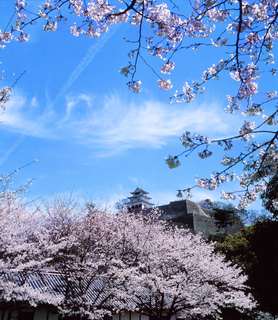The Kotohira-gu Shrine, also known as “Konpira-san,” has collected a number of fine works of art and craft from around Japan over its long history. The shrine houses up to 3,000 items, one of the largest collections of any shrine in Japan. Why have so many treasures been gathered here? Firstly, in the olden days, the Kotohira-gu Shrine received the patronage of rulers who put great efforts into protecting art and culture. Secondly, as it was respected and admired by people of all ranks, the shrine was donated a great number of valuable items. Thirdly, artists and intellectuals who visited the shrine were requested to dedicate works to it, and sometimes did so voluntarily. You can visit the following three facilities located along the approach to the Kotohira-gu Shrine.
1. TREASURE HOUSE
Homotsu-kan was the first registered museum in Japan, built during the Meiji period. It is worth visiting to see the massive architectural structure, a mixture of Eastern and Western culture. It holds a variety of works including Buddha statues, pictorial arts, Buddhist paintings, craftworks, and other historical folk materials. Here you can enjoy Japanese arts from olden times, especially the collection by painters of the Kano School. The Kano School of painting was established during the 15th century and flourished for over 400 years.
rs. They were heavily protected by the powerful masters of Japan during the age of the Ashikaga Shogunate, under the regimes of Oda Nobunaga and Toyotomi Hideyoshi, and the Tokugawa Shogunate. This successful and influential group of artists was made up of blood relatives with mentoring relationships among them. They all worked in a large workshop, led by the most talented painter of the time. The masterpieces of Kano Tanyu, one of the best painters, are also housed in the museum.
2. OMOTE-SHOIN
Omote-shoin was a reception hall used to welcome visitors to the Kotohira-gu Shrine. The building, together with its decorative sliding doors inside, has been designated as an important cultural property.
Seven rooms in Omote-shoin are connected by beautifully painted sliding doors. Among them, the following four rooms were painted by Maruyama Okyo (1733 - 1795): “Tsuru-no-ma” (“Room of cranes”), “Tora-no-ma” (“Room of tigers”), “Shichiken-no-ma” (“Room of the seven sages”), and “Sansui-no-ma” (“Room of the landscape”). Okyo was the best painter of the Edo period, and it was not easy for anyone to request works by him. It was Youzon (1739 - 1787), the man responsible for Omote-shoin at the time, who made it possible to invite Okyo.
Seven rooms in Omote-shoin are connected by beautifully painted sliding doors. Among them, the following four rooms were painted by Maruyama Okyo (1733 - 1795): “Tsuru-no-ma” (“Room of cranes”), “Tora-no-ma” (“Room of tigers”), “Shichiken-no-ma” (“Room of the seven sages”), and “Sansui-no-ma” (“Room of the landscape”). Okyo was the best painter of the Edo period, and it was not easy for anyone to request works by him. It was Youzon (1739 - 1787), the man responsible for Omote-shoin at the time, who made it possible to invite Okyo.
He had a large network of acquaintances, having been born and brought up in Kyoto. He always kept up with the latest trends in Kyoto after assuming his post at the Kotohira-gu Shrine, and invited a lot of cultural celebrities. His connections and efforts finally secured him the privilege of offering a job to Okyo. The highlight of Omote-shoin is “Tora-no-ma” (“Room of tigers”). You will see tiger-like feline animals painted on the doors – Okyo never had the chance to see a real tiger. Look carefully and you will see that Okyo depicted panthers and white tigers as well. Omote-shoin is one of few places that hold regular exhibitions of Okyo on the largest scale.
3. THE MUSEUM OF TAKAHASHI YUICHI
Takahashi Yuichi (1828 - 1894) is often referred to as the father of Western-style painting in Japan’s modern period. Yuichi worked hard to popularize oil paintings, which were less well known in Japanese culture in those days, by depicting objects with which the public was familiar. This is why he made rather peculiar choices of motif and layout, and sometimes chose subjects such as tofu, which he depicted with realistic brushwork. To further popularize oil painting, Yuichi established a private painting school in 1878.
He soon came to the Kotohira-gu Shrine, the sacred bastion of art and culture, to seek financial support. Recognizing the potential of the then-unknown painter and his eccentric pieces of work, the Kotohira-gu Shrine generously granted his wish and provided financial help. The museum exhibits 27 out of 35 paintings he dedicated to the Shrine, together with works created during his stay in Kotohira. A pleasant afternoon can be spent looking at his paintings and contrasting them with the present scenery of Kotohira.
INFORMATION - KOTOHIRA-GU SHRINE
[Address] 892-1 Kotohira-gu-cho Nakatadogun, Kagawa
[Access]
Train : 30min walk from JR Kotohira-gu Station & Kotoden Kotohira-gu Station
Car : 15min drive from Takamatsu Expressway Zentsuji Interchange
[Closed] Open 365 days a year
[Admission] Free
[Access]
Train : 30min walk from JR Kotohira-gu Station & Kotoden Kotohira-gu Station
Car : 15min drive from Takamatsu Expressway Zentsuji Interchange
[Closed] Open 365 days a year
[Admission] Free
16 records
 FIND SHIKOKU
FIND SHIKOKU













